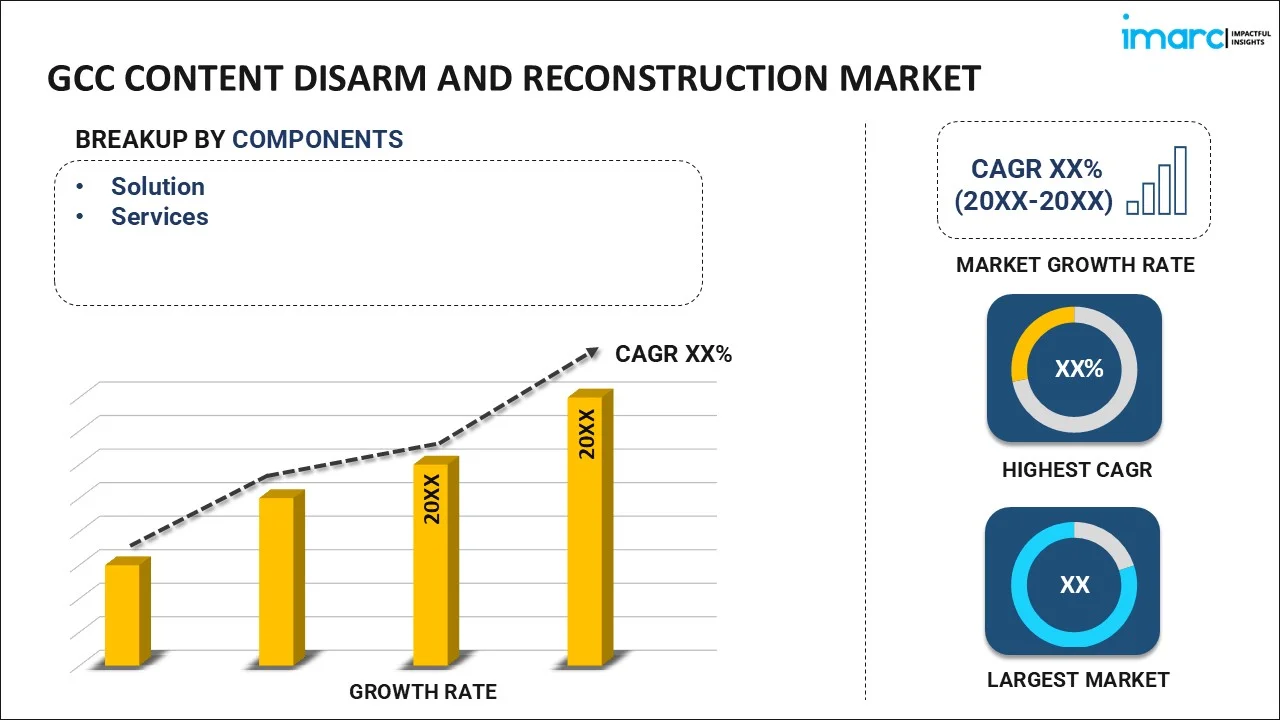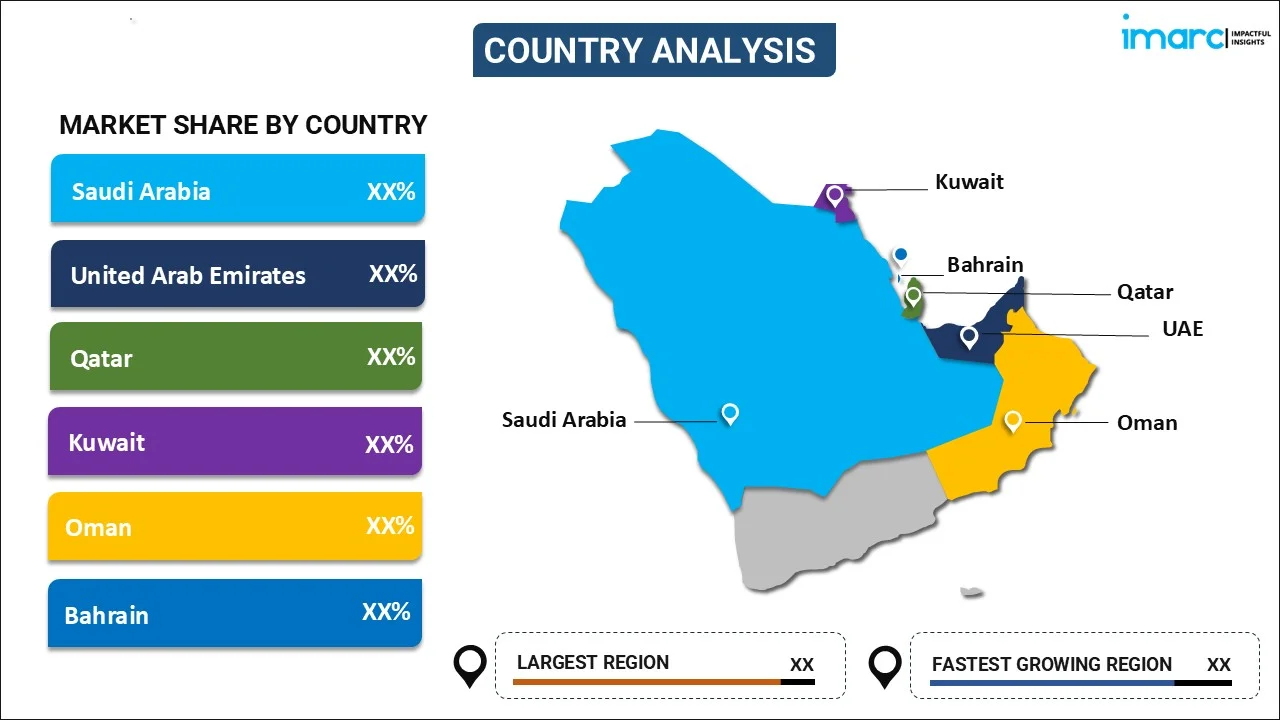
GCC Content Disarm and Reconstruction Market Report by Component (Solution, Services), Deployment Mode (On-premises, Cloud-based), Organization Size (Large Enterprises, Small and Medium-sized Enterprises), Application (Email, Web, File Transfer Protocol, Removable Devices), End User (BFSI, IT and Telecom, Energy and Utilities, Manufacturing, Healthcare, and Others), and Country 2025-2033
Market Overview:
GCC content disarm and reconstruction market size reached USD 9.4 Million in 2024. Looking forward, IMARC Group expects the market to reach USD 62.7 Million by 2033, exhibiting a growth rate (CAGR) of 21.6% during 2025-2033. The inflating need for compliance with data protection regulations implemented by government bodies across the region is primarily driving the market growth.
|
Report Attribute
|
Key Statistics
|
|---|---|
|
Base Year
|
2024 |
|
Forecast Years
|
2025-2033
|
|
Historical Years
|
2019-2024
|
| Market Size in 2024 | USD 9.4 Million |
| Market Forecast in 2033 | USD 62.7 Million |
| Market Growth Rate (2025-2033) | 21.6% |
Content disarm and reconstruction (CDR) is a cybersecurity strategy and technology designed to neutralize potential threats within files and documents while preserving the original content's functionality. It acts as a comprehensive defense mechanism against malicious content embedded in files, such as documents, images, or emails. Content disarm and reconstruction works by dismantling the incoming files, stripping them of potentially harmful elements, and then reconstructing a sanitized version with the same functionality but without the malicious code. This process helps prevent cyber threats, including malware, ransomware, and other forms of cyberattacks, from infiltrating and compromising systems. Content disarm and reconstruction is a crucial component in the cybersecurity arsenal, providing an additional layer of protection to ensure that organizations can safely handle and share digital content without exposing themselves to potential security risks.
GCC Content Disarm and Reconstruction Market Trends:
The GCC content disarm and reconstruction market is experiencing significant growth, driven by numerous key factors and emerging trends. A primary driver is the increasing number of cyber threats, prompting organizations in countries in the region to invest in advanced security solutions like CDR to protect their digital assets. Additionally, an influential trend in the GCC content disarm and reconstruction market is the integration of artificial intelligence (AI) and machine learning (ML) capabilities. These technologies enhance the ability of the solutions to intelligently identify and disarm even the most evasive forms of malicious content, providing a proactive defense against rapidly evolving cyber threats. Moreover, as GCC countries strengthen their cybersecurity frameworks, businesses are increasingly adopting content disarm and reconstruction solutions to ensure compliance with data security standards and protect sensitive information from breaches. In conclusion, the GCC content disarm and reconstruction market is anticipated to bolster , on the account of the increasing focus of key players on advanced threat protection and regulatory compliance.
GCC Content Disarm and Reconstruction Market Segmentation:
IMARC Group provides an analysis of the key trends in each segment of the market, along with forecasts at the regional and country levels for 2025-2033. Our report has categorized the market based on component, deployment mode, organization size, application, and end user.
Component Insights:

- Solution
- Services
The report has provided a detailed breakup and analysis of the market based on the component. This includes solution and services.
Deployment Mode Insights:
- On-premises
- Cloud-based
A detailed breakup and analysis of the market based on the deployment mode have also been provided in the report. This includes on-premises and cloud-based.
Organization Size Insights:
- Large Enterprises
- Small and Medium-sized Enterprises
The report has provided a detailed breakup and analysis of the market based on the organization size. This includes large enterprises and small and medium-sized enterprises.
Application Insights:
- Web
- File Transfer Protocol
- Removable Devices
A detailed breakup and analysis of the market based on the application have also been provided in the report. This includes email, web, file transfer protocol, and removable devices.
End User Insights:
- BFSI
- IT and Telecom
- Energy and Utilities
- Manufacturing
- Healthcare
- Others
The report has provided a detailed breakup and analysis of the market based on the end user. This includes BFSI, IT and telecom, energy and utilities, manufacturing, healthcare, and others.
Country Insights:

- Saudi Arabia
- United Arab Emirates
- Qatar
- Kuwait
- Oman
- Bahrain
The report has also provided a comprehensive analysis of all the major regional markets, which include Saudi Arabia, United Arab Emirates, Qatar, Kuwait, Oman, and Bahrain.
Competitive Landscape:
The market research report has also provided a comprehensive analysis of the competitive landscape in the market. Competitive analysis such as market structure, key player positioning, top winning strategies, competitive dashboard, and company evaluation quadrant has been covered in the report. Also, detailed profiles of all major companies have been provided.
GCC Content Disarm and Reconstruction Market Report Coverage:
| Report Features | Details |
|---|---|
| Base Year of the Analysis | 2024 |
| Historical Period | 2019-2024 |
| Forecast Period | 2025-2033 |
| Units | Million USD |
| Scope of the Report | Exploration of Historical Trends and Market Outlook, Industry Catalysts and Challenges, Segment-Wise Historical and Future Market Assessment:
|
| Components Covered | Solution, Services |
| Deployment Modes Covered | On-premises, Cloud-based |
| Organization Sizes Covered | Large Enterprises, Small and Medium-sized Enterprises |
| Applications Covered | Email, Web, File Transfer Protocol, Removable Devices |
| End Users Covered | BFSI, IT and Telecom, Energy and Utilities, Manufacturing, Healthcare, Others |
| Countries Covered | Saudi Arabia, United Arab Emirates, Qatar, Kuwait, Oman, Bahrain |
| Customization Scope | 10% Free Customization |
| Post-Sale Analyst Support | 10-12 Weeks |
| Delivery Format | PDF and Excel through Email (We can also provide the editable version of the report in PPT/Word format on special request) |
Key Questions Answered in This Report:
- How has the GCC content disarm and reconstruction market performed so far and how will it perform in the coming years?
- What has been the impact of COVID-19 on the GCC content disarm and reconstruction market?
- What is the breakup of the GCC content disarm and reconstruction market on the basis of component?
- What is the breakup of the GCC content disarm and reconstruction market on the basis of deployment mode?
- What is the breakup of the GCC content disarm and reconstruction market on the basis of organization size?
- What is the breakup of the GCC content disarm and reconstruction market on the basis of application?
- What is the breakup of the GCC content disarm and reconstruction market on the basis of end user?
- What are the various stages in the value chain of the GCC content disarm and reconstruction market?
- What are the key driving factors and challenges in the GCC content disarm and reconstruction?
- What is the structure of the GCC content disarm and reconstruction market and who are the key players?
- What is the degree of competition in the GCC content disarm and reconstruction market?
Key Benefits for Stakeholders:
- IMARC’s industry report offers a comprehensive quantitative analysis of various market segments, historical and current market trends, market forecasts, and dynamics of the GCC content disarm and reconstruction market from 2019-2033.
- The research report provides the latest information on the market drivers, challenges, and opportunities in the GCC content disarm and reconstruction market.
- Porter's five forces analysis assist stakeholders in assessing the impact of new entrants, competitive rivalry, supplier power, buyer power, and the threat of substitution. It helps stakeholders to analyze the level of competition within the GCC content disarm and reconstruction industry and its attractiveness.
- Competitive landscape allows stakeholders to understand their competitive environment and provides an insight into the current positions of key players in the market.
Need more help?
- Speak to our experienced analysts for insights on the current market scenarios.
- Include additional segments and countries to customize the report as per your requirement.
- Gain an unparalleled competitive advantage in your domain by understanding how to utilize the report and positively impacting your operations and revenue.
- For further assistance, please connect with our analysts.
 Inquire Before Buying
Inquire Before Buying
 Speak to an Analyst
Speak to an Analyst
 Request Brochure
Request Brochure
 Request Customization
Request Customization




.webp)




.webp)












